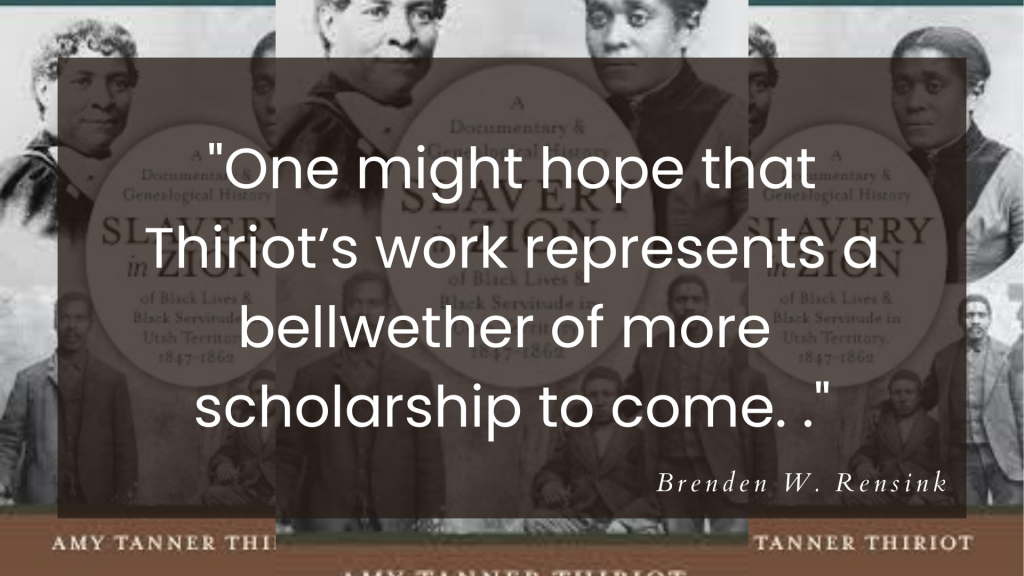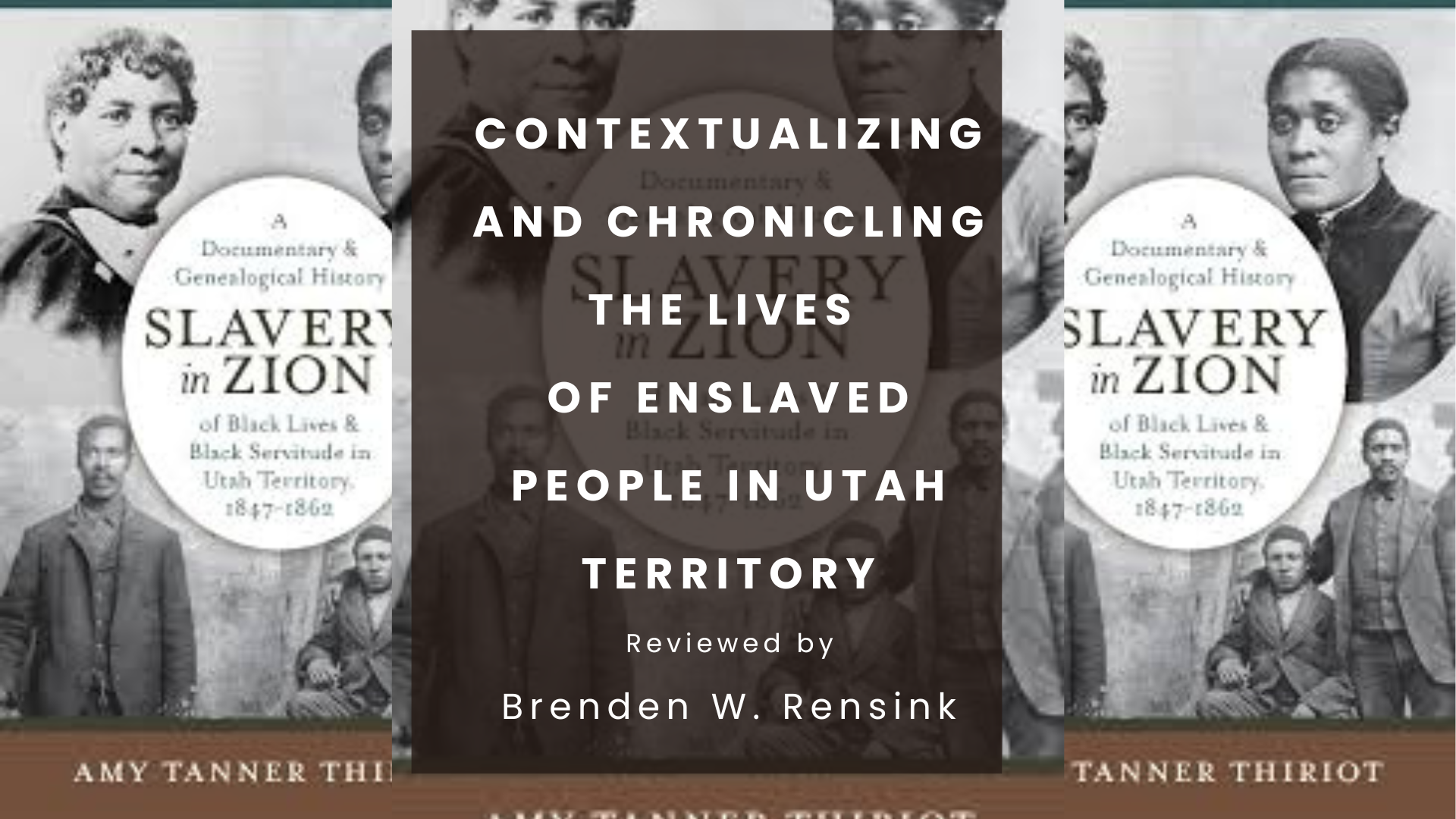Articles/Essays – Volume 58, No. 1
Contextualizing and Chronicling the Lives of Enslaved People in Utah Territory | Amy Tanner Thiriot, Slavery in Zion: A Documentary and Genealogical History of Black Lives and Black Servitude in Utah Territory, 1847–1862
Genealogical research has long played a prominent role in the theology and lived religious experiences of individuals, families, and communities associated with the Church of Jesus Christ of Latter-day Saints (LDS). Given this reality, one might postulate that average citizens of Utah—long the center of Church operations and population density—have more detailed and documented family histories than elsewhere in the country. Yet, as is the case with most historical endeavors, the more broadly one explores and the deeper one digs, the more obvious the deficiencies and incompleteness of our knowledge become. Historian and genealogical researcher Amy Tanner Thiriot’s recent book, Slavery in Zion: A Documentary and Genealogical History of Black Lives and Black Servitude in Utah Territory, 1847–1862, demonstrates this dynamic with striking clarity. For all the genealogical research that has been done in Utah, the histories of Black residents in Utah Territory are thin (and not simply because there were relatively few of them). Thiriot’s contributions here are multifold and merit serious consideration by scholars of the Church of Jesus Christ of Latter-day Saints and Utah history, as well as the general population who lives in Utah today or whose families have in the past.
Covering the years from 1847 to 1862, Thiriot’s Slavery in Zion sets out to identify the approximately one hundred Black individuals who ended up in Utah, narrate their experiences of slavery and servitude, explore the historical context of their lives, and provide detailed encyclopedic source data that others may use to investigate further. This documenting and relating of “their stories as completely and honestly as possible,” Thiriot argues, is essential if we hope to “honor the memory of men, women, and children who struggled under the heavy burdens of enslavement” (xi). The dominantly devotional nature of the near two centuries of LDS histories have largely avoided the discomfort of race relations by not engaging with them, so Thiriot’s early work to simply catalog who Utah Territory’s Black residents were was no easy task. After recovering names, Thiriot takes great strides in explaining how they ended up in Utah, their enslaved lives, and post-emancipation experiences in the territory and with Church members. The text is divided into two parts. “Part I: The Story of African American Slavery in Utah Territory” provides context and background, while “Part II: Biographical Encyclopedia of the Enslaved” offers intimate individual narratives and exhaustive primary source documentation.

As one might imagine, part 1’s background context is complicated and reveals histories full of contradiction. The early membership of the Church was dominated by northerners, but enslaver families did convert and migrate to Utah Territory. The legalized presence of enslaved people in the territory created theological and political tension, especially as ardent abolitionists and many who were more generally uncomfortable with racial servitude (including emigrants from nations where slavery had either not been prevalent or had already been abolished) worshiped and lived alongside enslavers. The racial restrictions enacted by the Church, the evolution of those policies, and decisions made by members in territorial government loom large over Thiriot’s work, as they should. However, these important issues sometimes dominate historical discussions of race in the early Church and suck the oxygen out of the room, as it were. Their thorny nature and true historical significance, unfortunately, sometimes lead historians to focus on them to the point of failing to adequately discuss other associated matters. Thiriot gracefully avoids this pitfall by persistently focusing on the lives of enslaved individuals. She does not ignore the broader context, but she also doesn’t allow it to overshadow. The resulting work is moving and illuminating—a striking demonstration of the power of bottom-up and on-the-ground social history.
Part 2’s encyclopedic entries of enslaved individuals include brief narrations of their lives, identification (when possible) of documented family members, their enslavers, wagon companies that brought them to Utah, burial locations, miscellaneous notes, and source bibliographies. The book would be a monumental contribution if it was this alone. Thiriot also includes information on other enslaved individuals in early Church history who did not end up in Utah, Black residents of Utah territory who have been misrepresented in various forms in prior histories, and discussion of Latter-day Saints in Utah whose families were documented or potential former enslavers.
One might hope that Thiriot’s work represents a bellwether of more scholarship to come. Slavery in Zion certainly contributes to a historiographic movement underway. Recent works by W. Paul Reeve, Max Perry Mueller, Matthew L. Harris, LaJean Purcell Carruth, Christopher B. Rich, Tonya Reiter, and others, or projects and organizations such the Century of Black Mormons, BYU Slavery Project, Sema Hadithi Foundation, or Brigham Young Racial Reconciliation Ministry all attest to growing scholarly and public interest. In the context of these and other recent works, Thiriot’s contribution fits well. Indeed, it is the type of work that would have greatly aided the many others had it been published a decade or two earlier. Slavery in Zion provides a methodological blueprint for how to approach these histories with humility, reverence, and solemn focus on individual lives. It also offers up a wealth of data and sources to aid future research. These are the very things needed at the foundation of the study of race and the Church. Perhaps, we have rushed to the important, but oft-overwhelming, discussions of Church policy without such a foundation. Pursuing such debates on the firm historical footings offered by Thiriot and others, including those noted above, will produce discussion that is not only more contextualized and historically accurate but empowered to engender understanding, reckoning, reconciliation, and productive healing within and between communities.
Amy Tanner Thiriot. Slavery in Zion: A Documentary and Genealogical History of Black Lives and Black Servitude in Utah Territory, 1847–1862. Salt Lake City: University of Utah Press, 2022. 384 pp. Paperback: $39.95. ISBN: 9781647690854.


 Back to full Issue
Back to full Issue

